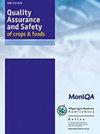肉苁蓉棘皮精油的性质评价:水馏和微波辅助水馏提取方法的比较
IF 5.3
3区 农林科学
Q1 FOOD SCIENCE & TECHNOLOGY
引用次数: 2
摘要
沙漠Acantholipia desicola(Rica Rica)是智利高地的一种本地灌木,用作药用植物和食用调味品。本研究的目的是比较其精油(EO)的物理、抗氧化和抗菌特性,基于加氢蒸馏(HD)和微波辅助加氢蒸馏的工艺参数和提取方法,并评估脂肪酸的存在。评价了工艺性能以及颜色参数、折射率、脂肪酸分布、抗氧化活性和抗菌活性。HD的最佳工艺条件为90分钟、420 W和150 g 1000 mL–1;对于MAHD,它们分别为90分钟、700 W和200 g 1000 mL–1,产率分别为0.45和0.49 mL 100 g-1,抗氧化能力分别为2.38和3.92μmol Trolox g-1。采集季节、提取方法及其参数影响产量和脂肪酸组成,影响EOs的活性。就草药的质量、加工时间以及能源效率和环境影响而言,MAHD的提取效率高出8%。两种方法提取的EOs对链球菌和蜡样芽孢杆菌均表现出轻微的抑制作用,MAHD EO对链球菌a组表现出高度的抑制作用。根据其潜在的工业应用,可以设定提取方法的类型和工艺参数以获得合适的EOs。本文章由计算机程序翻译,如有差异,请以英文原文为准。
Assessing properties of acantholippia deserticola (Phil.) moldenke essential oil: Comparison between hydrodistillation and microwave-assisted hydrodistillation extraction methods
Acantholippia deserticola (Rica-Rica) is a native shrub of the Chilean highlands used as a medicinal plant and food dressing. The objective of this study was to compare the physical, antioxidant and antimicrobial characteristics of its essential oil (EO), based on the process parameters and extraction methods using hydrodistillation (HD) and microwave-assisted hydrodistillation (MAHD), and assessing presence of fatty acids. The process performance as well as the colour parameters, refractive index, fatty acid profile, antioxidant activity and antimicrobial activity were evaluated. The best process conditions for HD were 90 min, 420 W and 150 g 1000 mL–1; for MAHD, these were 90 min, 700 W and 200 g 1000 mL–1, with yields of 0.45 and 0.49 mL 100 g-1 and antioxidant capacities of 2.38 and 3.92 μmol Trolox g-1 respectively. The collection season, extraction method and its parameters affected the yield and fatty acid profile, influencing EOs’ activity. In terms of mass of herbs, process time as well as energy efficiency and environmental impact, the extraction of MAHD was 8% more efficient. EOs extracted by both methods show a slight inhibitory effect on Streptococcus sp. and Bacillus cereus, and MAHD EO showed a highly inhibitory effect on Streptococcus Group A. The type of extraction method and the process parameters could be set to obtain suitable EOs according to its potential industrial application.
求助全文
通过发布文献求助,成功后即可免费获取论文全文。
去求助
来源期刊

Quality Assurance and Safety of Crops & Foods
FOOD SCIENCE & TECHNOLOGY-
CiteScore
4.60
自引率
7.50%
发文量
61
审稿时长
1 months
期刊介绍:
''Quality Assurance and Safety of Crops & Foods'' is an international peer-reviewed journal publishing research and review papers associated with the quality and safety of food and food sources including cereals, grains, oilseeds, fruits, root crops and animal sources. It targets both primary materials and their conversion to human foods. There is a strong focus on the development and application of new analytical tools and their potential for quality assessment, assurance, control and safety. The scope includes issues of risk assessment, traceability, authenticity, food security and socio-economic impacts. Manuscripts presenting novel data and information that are likely to significantly contribute to scientific knowledge in areas of food quality and safety will be considered.
''Quality Assurance and Safety of Crops & Foods'' provides a forum for all those working in the specialist field of food quality and safety to report on the progress and outcomes of their research.
 求助内容:
求助内容: 应助结果提醒方式:
应助结果提醒方式:


